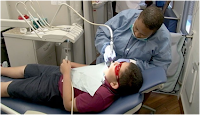By Steve Pollock
 Did you catch the ABC News with Diane Sawyer this Wednesday? There was a moving story on children’s dental health.
Did you catch the ABC News with Diane Sawyer this Wednesday? There was a moving story on children’s dental health.It was part of a new ABCNews series called, “Hidden America.” ABC says this series is about the people, places and stories of struggle and hope that are not apparent to many Americans.
This first segment was about America’s “Invisible Health Crisis” -- dental disease. It is a problem most American’s probably never think about. We know it very well.
Did you know that 16 million children did not receive even the most basic preventive dental care during 2009?
Did you know that Emergency Rooms say they are treating greater numbers of toddlers whose teeth are blackened from decay and bacteria and multiple cavities?
And it is not just low income children!
Thankfully, this story is gradually gaining momentum in the mainstream media and more people are discovering the immense impact poor dental health has on our lives. There are other equally moving articles in The New York Times, USA Today, PBS Newshour, and Consumer Reports.
If children can be seen early and regularly and receive the benefits of fluoride varnish and sealants, much of this disease could be prevented.
Silent, invisible, and hidden are three words ABC used describe this oral health crisis. We’re working to change that.






